
ATW-INTERNATIONAL JOURNAL FOR NUCLEAR POWER
Scope & Guideline
Shaping the Future of Nuclear Power Generation
Introduction
Aims and Scopes
- Nuclear Reactor Technology and Engineering:
The journal emphasizes research on the design, operation, and safety of nuclear reactors, including advanced reactor concepts such as Small Modular Reactors (SMRs) and Generation IV technologies. - Fuel Cycle and Materials Science:
It explores innovations in nuclear fuel development, including the performance and safety of different fuel types, fuel recycling methods, and materials used in reactors. - Nuclear Safety and Risk Assessment:
There is a strong focus on methodologies for assessing and managing risks associated with nuclear power plants, including accident prevention and emergency preparedness. - Policy, Regulation, and Public Perception:
The journal discusses the regulatory frameworks governing nuclear energy, public attitudes towards nuclear power, and the socio-political implications of nuclear energy policies. - Decommissioning and Waste Management:
Research related to the decommissioning of nuclear facilities and the management of radioactive waste is a significant focus area, emphasizing safe and sustainable practices. - International Collaboration and Global Trends:
The journal highlights international developments in nuclear energy, including collaborations between countries and organizations to enhance nuclear safety and technology sharing.
Trending and Emerging
- Sustainable Nuclear Technologies:
There is an increasing interest in sustainable practices within nuclear energy, including research on advanced reactors that minimize waste and enhance safety. - Integration of Nuclear with Renewable Energy:
Emerging discussions focus on the integration of nuclear power with renewable energy sources, exploring how nuclear can complement renewables to achieve energy transitions. - Nuclear Innovation and Digitalization:
The journal highlights advancements in digital technologies applied to nuclear energy, such as AI, robotics, and virtual reality for training and operational efficiency. - Public Engagement and Education Initiatives:
There is a rising trend in papers addressing the importance of public engagement and education in nuclear science, aiming to improve the understanding and acceptance of nuclear technologies. - Climate Change Mitigation Strategies:
The journal increasingly features articles on the role of nuclear energy in meeting climate targets, emphasizing its potential for significant contributions to low-carbon energy systems.
Declining or Waning
- Conventional Nuclear Power Expansion:
Discussions surrounding the expansion of traditional nuclear power plants have decreased, possibly reflecting a growing emphasis on advanced technologies and alternative energy sources. - Historical Perspectives on Nuclear Energy:
Papers focusing on historical analyses of nuclear power, including its development and past controversies, appear to be waning as the focus shifts towards future-oriented discussions. - Economic Viability of Nuclear Power:
The economic discussions related to the competitiveness of nuclear energy compared to renewables have diminished, likely as the market dynamics evolve with the rise of renewable energy technologies.
Similar Journals

Eksplorium-Buletin Pusat Teknologi Bahan Galian Nuklir
Advancing Nuclear Knowledge for a Sustainable FutureEksplorium-Buletin Pusat Teknologi Bahan Galian Nuklir is a pivotal open-access journal dedicated to the field of nuclear material technology, published by the Pusat Teknologi Bahan Galian Nuklir-BATAN. Since its inception in 2011, this journal has been committed to disseminating high-quality research that explores advancements in the utilization and management of nuclear materials, ensuring that vital knowledge is accessible to researchers, professionals, and students globally. With an ISSN and E-ISSN of 0854-1418, Eksplorium serves as a valuable platform for contributors looking to share their findings, fostering collaboration and innovation in a field that is increasingly relevant to energy sustainability and environmental safety. Situated in Jakarta, Indonesia, this journal not only enhances the scientific landscape but also champions open access principles to promote the global exchange of knowledge.

JOURNAL OF RADIOANALYTICAL AND NUCLEAR CHEMISTRY
Pioneering discoveries in nuclear chemistry and health.JOURNAL OF RADIOANALYTICAL AND NUCLEAR CHEMISTRY, published by Springer, serves as a vital platform for the dissemination of research in the fields of analytical chemistry, nuclear science, and radiochemistry. With an ISSN of 0236-5731 and an E-ISSN of 1588-2780, this journal has been a beacon of innovation and scholarly communication since its inception, transitioning from converged years of 1977-1979 to its current continuity from 1984 to 2024. Positioned in the Q3 category for analytical chemistry and other related fields such as health, toxicology, and nuclear engineering, it boasts significant standings in the Scopus rankings, reflecting its relevance and impact within these disciplines. The journal emphasizes open access, encouraging broader accessibility to quality research, which is critical for students, professionals, and ongoing global scientific discussions. As a leader in its domain, the JOURNAL OF RADIOANALYTICAL AND NUCLEAR CHEMISTRY is committed to advancing the understanding of radioactive materials, environmental safety, and health applications, ensuring its readers remain at the forefront of emerging trends and discoveries.
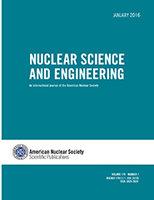
NUCLEAR SCIENCE AND ENGINEERING
Advancing the Frontiers of Nuclear InnovationNUCLEAR SCIENCE AND ENGINEERING, published by Taylor & Francis Inc, is a leading journal in the field of nuclear energy and engineering, providing a vital platform for disseminating cutting-edge research and advancements from both academia and industry. With an ISSN of 0029-5639 and an E-ISSN of 1943-748X, the journal boasts a notable impact factor and is categorized in the Q2 quartile for 2023, reflecting its influence and quality in the field. Covering a comprehensive scope from the inception of nuclear technology in 1969 to contemporary advancements forecasted for 2024, it ranks #38 out of 77 in the Scopus Energy – Nuclear Energy and Engineering category, placing it in the 51st percentile. Although the journal is not open access, it remains essential for researchers, professionals, and students seeking to stay abreast of the latest developments and innovations in nuclear science. Located in the heart of Philadelphia, NUCLEAR SCIENCE AND ENGINEERING contributes significantly to the advancement of nuclear engineering knowledge and practice, making it a crucial resource for anyone involved in this dynamic field.
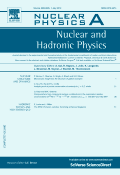
NUCLEAR PHYSICS A
Exploring the Depths of High Energy PhysicsNUCLEAR PHYSICS A, published by Elsevier, is a leading international journal dedicated to the fields of Nuclear and High Energy Physics. With an ISSN of 0375-9474 and E-ISSN 1873-1554, the journal has been pivotal in advancing research since its inception in 1967 and is set to continue influencing the discipline through 2025. It holds a commendable Q2 classification in the 2023 category of Nuclear and High Energy Physics, ranking 32nd out of 87 journals in its field according to Scopus, placing it in the 63rd percentile. NUCLEAR PHYSICS A provides valuable insights and disseminates cutting-edge research, aiding researchers, professionals, and students in their academic and practical pursuits. Though it does not currently offer open access, the journal remains a vital resource for those engaged in the exploration of nuclear phenomena and theoretical advancements in high-energy physics.

Nuclear Physics and Atomic Energy
Advancing knowledge in nuclear physics and energy.Nuclear Physics and Atomic Energy is a reputable open-access journal that focuses on the fields of nuclear physics and high-energy physics, providing a forum for researchers, professionals, and students to share their findings and advancements. Published by the Institute of Nuclear Research, National Academy of Sciences of Ukraine, this journal has been committed to disseminating knowledge since its inception in 2006, ensuring that scientific advancements remain accessible to a global audience. With an ISSN of 1818-331X and an E-ISSN of 2074-0565, the journal features a diverse array of articles that span the continued exploration and application of nuclear phenomena. Although currently categorized in the Q4 quartile for Nuclear and High Energy Physics in 2023, the journal is steadily working towards increasing its impact and engagement within the academic community. With a Scopus rank of #74 out of 87 in its category, it serves as a valuable resource for advancing crucial research in a vital scientific area. Researchers are encouraged to contribute their innovative studies to foster collaboration and knowledge sharing in this dynamic field.
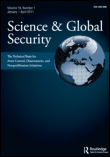
Science & Global Security
Exploring the Nexus of Science and SecurityScience & Global Security, published by Routledge Journals, Taylor & Francis Ltd, is an esteemed academic journal that explores the intersection of science, security, and global policy from an interdisciplinary perspective. Since its inception in 1989, the journal has served as a vital platform for disseminating research that addresses the complex challenges posed by security threats in a globalized world, including nuclear proliferation, environmental security, and technological impacts on peace. Although currently classified in the Q4 quartile within the Engineering (miscellaneous) category, the journal is dedicated to fostering dialogue among researchers, policymakers, and practitioners, making it a crucial resource for those engaged in the fields of security studies and international relations. The journal, based in the United Kingdom, operates on a subscription-based model, ensuring that high-quality research is accessible to a wide professional audience. By continuously welcoming diverse methodologies and perspectives, Science & Global Security plays an essential role in shaping informed discussions around the pressing security dilemmas of our time.

PHYSICAL REVIEW C
Elevating Knowledge in High-Energy PhysicsPHYSICAL REVIEW C is an esteemed journal published by the American Physical Society, dedicated to advancing knowledge in the fields of nuclear and high-energy physics. With a proud ISSN of 2469-9985 and an E-ISSN of 2469-9993, it has established itself as a leading journal, currently ranked in the Q1 category for its field in 2023, positioning itself in the top tier of scholarly publications. Based in the heart of the United States, at One Physics Ellipse, College Park, MD, PHYSICAL REVIEW C is known for its rigorous peer-review process and is a vital platform for researchers to share their pioneering findings. As part of a prestigious lineup backed by an impressive impact factor, this journal garners significant attention, reflected in its Scopus ranking as #18 out of 87 in the Nuclear and High Energy Physics category, placing it within the 79th percentile. While it currently does not offer open access options, it remains an essential resource for professionals and students seeking to deepen their understanding of nuclear interactions, reaction dynamics, and the fundamental principles governing subatomic particles. The convergence of innovative research from 2016 to 2024 makes it a timely reservoir for groundbreaking studies, thus reinforcing its importance in the scientific community.
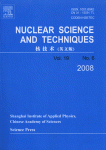
Nuclear Science and Techniques
Advancing the Frontiers of Nuclear KnowledgeNuclear Science and Techniques is a distinguished peer-reviewed journal published by Springer Singapore Pte Ltd, dedicated to advancing the fields of nuclear science and engineering. With an impressive impact factor reflected in its 2023 quartile rankings—Q2 in Nuclear and High Energy Physics and Q1 in Nuclear Energy and Engineering—the journal serves as a vital resource for researchers, professionals, and students alike. Covering a breadth of topics from nuclear physics to energy applications, it offers a platform for innovative research and developments in the nuclear domain. The journal, indexed under ISSN 1001-8042 and E-ISSN 2210-3147, aims to foster scientific exchange and collaboration within the community by publishing high-quality articles that contribute significantly to the field. Committed to maintaining an open-access ethos, it enhances visibility and accessibility of critical knowledge, making it an essential source for current insights and trends in nuclear science.
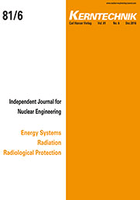
KERNTECHNIK
Empowering academics to shape the landscape of nuclear safety.KERNTECHNIK is a distinguished journal specializing in the fields of Materials Science, Nuclear and High Energy Physics, and Nuclear Energy and Engineering. Published by WALTER DE GRUYTER GMBH, this journal has continuously contributed to advancing knowledge and research in nuclear technologies and related safety measures since its inception in 1969. With an ISSN of 0932-3902 and an E-ISSN of 2195-8580, KERNTECHNIK serves as a vital platform for academics and professionals seeking to delve into both theoretical and practical aspects of nuclear science and technology. Though listed in the Q4 quartile across multiple categories in 2023, the journal's commitment to publishing rigorously peer-reviewed articles ensures that it remains a respected resource, facilitating academic discourse and innovation. It is particularly aligned for those conducting research or working in safety, risk, reliability, and quality within the nuclear sector, and its extensive historical archive allows for in-depth exploration of evolving technologies. Aimed at foster cooperation between researchers, policymakers, and industry experts globally, KERNTECHNIK continues to play an important role in shaping the future of nuclear science.

Journal of Condensed Matter Nuclear Science
Innovating Tomorrow's Nuclear Solutions Through Condensed Matter Insights.The Journal of Condensed Matter Nuclear Science, published by the International Society for Condensed Matter Nuclear Science in the United Kingdom, serves as a pivotal platform for researchers exploring the intersections of condensed matter physics and nuclear science. With an ISSN of 2227-3123, this journal has been actively contributing to the academic discourse from its inception in 2016 through its latest volume in 2022. Although classified in Q4 quartiles across various categories, including Atomic and Molecular Physics, Condensed Matter Physics, and Nuclear Energy and Engineering, the journal provides a unique lens on innovative approaches and perspectives that could significantly impact future research directions. This open-access journal appeals to an audience keen on investigating the theoretical and experimental aspects of condensed matter nuclear science, fostering a collaborative environment for scientists, engineers, and students alike. By advancing discussions in this niche field, it aims to attract attention and inspire groundbreaking discoveries that underpin the evolving landscape of nuclear energy and applications.